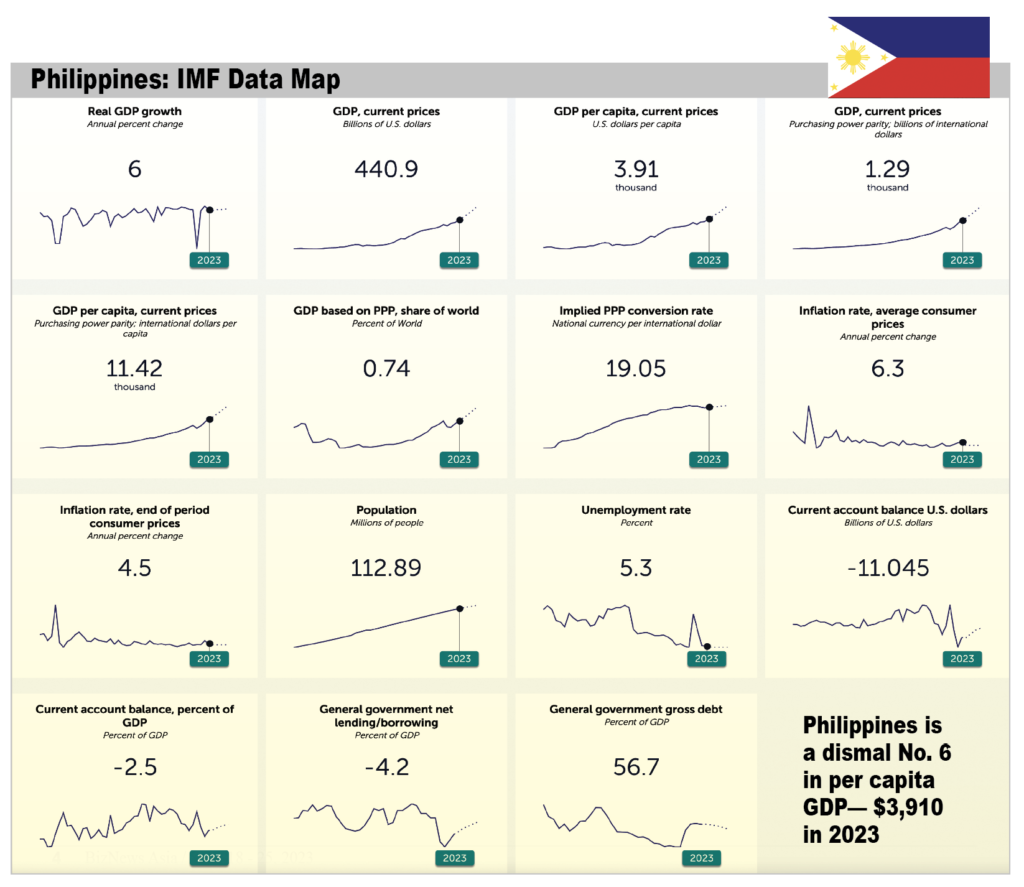By Tony Lopez
Recent governments in the Philippines have exulted about the so-called robust economic growth.
Yes, indeed, the Philippines has been growing strongly. But growth has not been as good as the growth rates of its neighbors in Asia. Compared with the performance of its Asian neighbors, the Philippine economic decline has been breathtaking in its depth and breadth.
In 2000, the Philippines was the fourth richest country in the ASEAN region in terms of per capita GDP or the value of the economy in current US dollars divided by the population. That year, the Philippines had a per capita GDP of $1,090—half of that of Thailand ($2,000) but 1.25x that of Indonesia ($870), and 2.19x that of Vietnam ($498). Malaysia was 4x richer ($4,350) while Singaporeans were 21.9x richer than the Filipinos.
At fourth place among the ASEAN’s major countries with $1,090 per capita income, the Philippines was already showing a sharp decline in economic achievements.
PH was Asia’s richest country
In the 1960s, the Philippines was the richest country in Asia, richer than Japan itself. In fact, over a century earlier, in 1851, the Philippines had established Southeast Asia’s first commercial bank, the Bank of the Philippine Islands. Bank of PI was also the region’s first central bank.
In 1882, 31 years after Filipinos established Southeast Asia’s first bank, they also erected the region’s first water and sewerage system, the Carriedo Water System, today the Metropolitan Waterworks and Sewerage System, or Nawasa.
In 1965, or 58 years ago, when Singapore was founded, it had no water, no toilets, and no resources to speak of. Today, it is ASEAN’s richest country.
In 1927, Filipinos put up Southeast Asia’s first stock exchange, the Manila Stock Exchange. Being the first, it was also the biggest stock exchange for many decades in the region. Today, the Philippine Stock Exchange is one of ASEAN’s smallest bourses, with fewer listed companies than the stock exchanges of its neighbors.
In the 1970s, under the Marcos I regime, the Philippines had built the region’s first expressways and its first elevated railway systems. Manila, under Delta Motor Corp., was producing the region’s first auto engine blocks outside of Japan.
The Philippines was an industrialized country before many of its neighbors, notably, Malaysia, Singapore, and Vietnam became democratic independent states. Manila was also the center of culture in Asia. It had built the Cultural Center of the Philippines, in 1966, and the world-class Philippine International Convention Center in 1976. The same year, Manila had built more five-star hotels than did Vietnam or Indonesia or even Malaysia.


What happened?
What has happened since those halcyon years of culture, dynamism and growth?
Answer: A decline, a breathtaking decline.
Today, in ASEAN, the Philippines is a dismal No. 6 in per capita GDP– $3,910, according to IMF data. In 2023, Singapore has per capita income of $91,100, 23.3x that of the Philippines; Malaysians ($13,380) are 3.42x richer; Thais ($8,180) 2.09x; Indonesians ($5,020) 1.28x; and the Vietnamese ($4,440) make 1.14 times more income.
Beaten badly
We have been beaten badly by Indonesians and the Vietnamese in the race for better incomes for their people. In the year 2000, Indonesians had half the literacy of Filipinos. Today, nearly all (99.76%) of Indonesians are literate.
Of course, Filipinos also claim a literacy rate of 99%. But the evidence points to the contrary.
Out 15-year-olds are rated as the most stupid kids on earth, in terms reading, math, and science, thanks to a Department of Education that has now padded its budget with half a billion pesos of – “intelligence” funds, even as million kids could not return to school because of stark poverty.
Signs are that the Philippines will continue to be clobbered by its ASEAN neighbors. Unless, of course, it shapes up. Now.
Per IMF projections, the Philippines will remain a cellar dweller in the economic powerhouse race, price ceilings or no price ceilings.
By 2028, the year when we elect the successor to President Bongbong Marcos Jr., the Philippines will remain No. 6 in per capita income, with $5,380, up 37.5% from 2023 levels of $3,910.
Between 2023 and 2028, the Singapore economy as measured by per income will grow 21.6%, from $91,100 to $110,840 ((No. 1); Malaysian, 34.3%, from $13,380 to $17,970 (No. 2); Thai, 33.25%, from $8,180 to $10,900 (No. 3); Indonesian, 40.8%, from $5,020 to $7,070 (No. 4); and Vietnamese, by 55.8%, from $4,480 to $6,960 (No. 5).
Between 2000 and 2028, China’s economy, in per capita income terms, would have grown 20-fold, from $951 in 2000 to $19,620; India’s will expand, from $449.70 eight-fold, from $449.70 to $3,720.
In the same 28-year period, Philippine per capita income would have grown just five-fold, from $1,090 to $5,380.
From the unrivalled No. 1 during the 19th century in prosperity to just No. 6 in the first quarter of the 21st century. Filipinos will do so even while remaining the most prayerful people in Asia, bar none, thanks its 86% Catholicism.
Analysts blame a number of factors for the Philippines losing Asia’s Economic Miracle game.
The Top 4 excuses: 1) Corruption; 2) the third most restrictive investment climate in the world, per OECD; 3) among the highest electricity prices in the world; and 4) among the highest priced and slowest telcos in the world.
Corruption? Well, the Indonesians, Vietnamese, the Thais and the Malaysians are even more corrupt than our politicians, despite Baguio Mayor Benjamin Magalong’s claim that Filipino politicians routinely grab 40% of budgets for projects, aside from being the contractors and suppliers of these same projects. Also, the United States is probably the most corrupt country on earth. Still, it is the world’s richest nation ($23 trillion GDP). And hey, China and India are tops too in corruption, cronyism and abuses against democratic forces.
